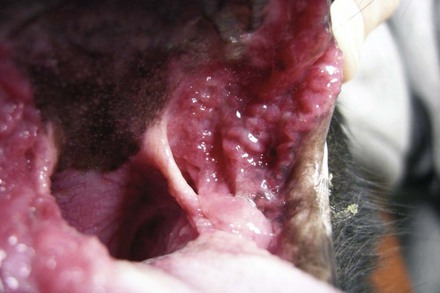10 Feline Dentistry
When you have completed this chapter, you will be able to:
• Differentiate between stomatitis, gingivitis, and periodontitis.
• Differentiate between type 1 and type 2 feline chronic ulcerative gingivostomatitis.
• List the diagnostic testing used for evaluation of patients with suspected feline chronic ulcerative gingivostomatitis.
• Describe the management of patients with feline chronic ulcerative gingivostomatitis.
• Describe the classification scheme used to stage tooth resorption.
Association of American Feed Control Officials
Chronic ulcerative gingivostomatitis
Feline orofacial pain syndrome
Feline Chronic Ulcerative Gingivostomatitis
Cause
Feline CUGS is frustrating and can be difficult to manage. Type 1 cases involve only alveolar and labial/buccal mucositis/stomatitis, and type 2 cases include caudal mucositis/stomatitis (with or without alveolar and labial/buccal mucositis/stomatitis). Type 1 cases may be manageable and teeth can be maintained, whereas type 2 cases tend to be less so (Figure 10-1).
Stage 1: Complete oral health assessment and treatment (COHAT) and intraoral radiographs are mandatory. Teeth affected by resorption or periodontitis must be extracted. Retained tooth root tips must be extracted. If the client is unwilling or unable to provide this care, extraction of all caudal teeth may be a more appropriate option. Antibiotics, steroids, nonsteroidal antiinflammatory drugs (NSAIDs), and pain medications are prescribed as indicated for “rescue therapy.”
Stage 2: When the client cannot perform home care, extraction of all teeth caudal to the canines may be helpful. The canines and incisors can be spared if (1) the gingiva and bone are in perfect health, (2) the client is willing and able to brush the remaining teeth daily, (3) the client realizes that COHAT of the remaining teeth will be necessary every 4 to 12 months, and (4) the client accepts that quite often the canines and incisors need to be removed some time in the future. After this treatment, rescue therapy is provided again as appropriate.
Stage 3: For those cats that still do not respond, the next step is extraction of all teeth. Early trials are showing promise with Omega Interferon, which may be administered by local injection and followed by daily oral dosing. At this time, Omega Interferon must be imported from Europe, does not have United States Department of Agriculture (USDA) approval, and must be handled very carefully to maintain potency.
Stage 4: For those cats that still do not respond, long-term antibiotic and steroid therapy is used to control the patient’s condition. This treatment will need to be continuous and adapted to each patient.
Stay updated, free articles. Join our Telegram channel

Full access? Get Clinical Tree



